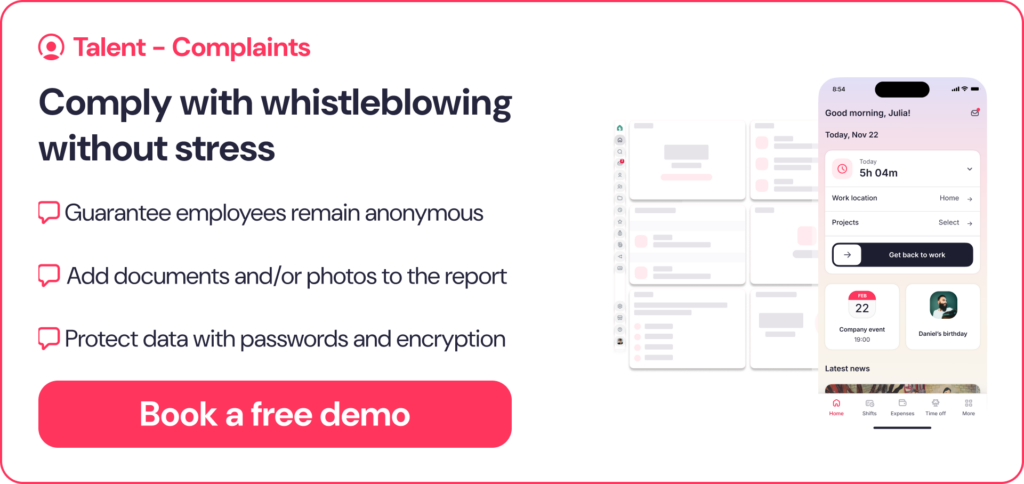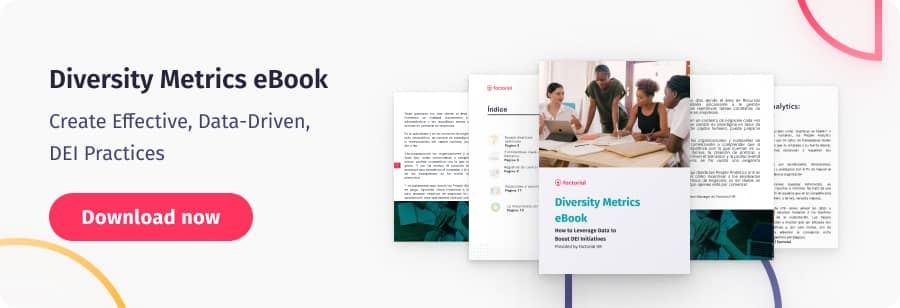George Floyd’s public murder in 2020 sent shockwaves around the world. As a direct result of this event and the subsequent Black Lives Matter protests, organizations were faced with the reality of discrimination and its impact on society. And this led to increasing demand for initiatives promoting Diversity, Equity & Inclusion in the workplace. It also resulted in greater awareness of a need to understand and address the effects of disparate treatment and disparate impact.
TABLE OF CONTENTS
- Disparate Treatment Definition
- Disparate Treatment vs. Disparate Impact
- Disparate Treatment Example
- Disparate Impact Meaning
- What Are the Five Protected Classes Under Title VII
- How to Avoid Disparate Treatment
- Gain employee feedback with HR software ✅
As an employer, it is vital that you implement policies and initiatives that foster a diverse workforce. And the first step in achieving this is understanding what disparate treatment is. Failure to do so can leave you wide open to potential lawsuits. It also prevents you from creating a workplace environment where top talent wants to work.
Join us as we discuss what disparate treatment is and how you can avoid it. We will also break down the five protected classes under Title VII of the Civil Rights Act to help you get a better understanding of disparate treatment discrimination.
Disparate Treatment Definition
Disparate treatment is one of the theories of discrimination under Title VII of the Civil Rights Act of 1964. Title VII protects employees and job applicants from employment discrimination based on race, color, religion, sex, and national origin. In other words, disparate treatment discrimination is when you demonstrate discriminatory intent against an applicant or employee as a direct result of them being a member of a protected class.
Title VII covers all aspects of employment, including recruitment, selections, terminations, and other decisions concerning the terms and conditions of employment. This includes the refusal to hire or promote, reasons for termination, or the creation of company policies that are unrelated to Bona Fide Occupational Qualification (BFOQ).
If an employee can provide comparative evidence of disparate treatment, even if discrimination was not the sole motivating factor, you could be held liable in a court of law. Disparate treatment can also have a severe impact on reputation, turnover and employee morale, resulting in decreased productivity and profits.
To avoid this, you should focus on creating a diverse workforce. You should also foster cultural competence so that people of different races, religions, genders, sexual identities and ages are all represented and respected in your company.
Disparate Treatment vs. Disparate Impact
It’s important to highlight the difference between disparate treatment discrimination and disparate impact (commonly referred to as adverse impact). You might be thinking, “What is the difference between disparate treatment and disparate impact?”
The main difference is that:
Disparate impact = unintentional discrimination
Disparate treatment = intentional discrimination
In other words, disparate treatment is an intentional action or behavior, where policies and procedures have been intentionally created with the aim of discriminating against protected classes. In contrast, disparate impact occurs as a result of policies, procedures or practices that have an inadvertent negative effect on a protected class. It all comes down to intent.
Disparate treatment vs impact examples:
- Example of disparate treatment: providing higher pay to men than women for performing the same job (intentional discrimination)
- Example of disparate impact: hiring more men than women as construction workers as a result of physical height or strength (unintentional discrimination).
Disparate Treatment Example
To support a disparate treatment claim, an employee needs to establish four elements:
- They are a member of a protected class
- You are aware that they are a member of a protected class
- An act of disparate workplace discrimination occurred (unfair performance review, refused a bonus, etc.)
- You treated individuals not from a protected protected class more favorably.
Let’s take a look at a more detailed example to help explain the concept.
Bob and Maria both work at a call center. Bob is a white male who has spent his entire life living in the US. Maria is a female from Venezuela who has been a US citizen for the past 10 years.
Both Bob and Maria received 5 customer complaints over the past month. The company gives Bob a verbal warning but fires Maria. Both employees committed the same violation, but they have been treated differently.
Unless the employer can prove there was a justifiable reason why Maria was fired but Bob wasn’t, then this would be a clear example of disparate treatment. The same violation and circumstances must merit the same punishment. In other words, Maria was seemingly fired as a direct result of being a member of a protected class. And this is discrimination.
Disparate Impact Definition
Disparate impact means that, despite the absence of explicit discriminatory intent, a certain company policy, practice, or decision has a disproportionately negative effect on a member of a protected class – a specific group of individuals, often defined by characteristics such as race, gender, age, or other protected attributes.
Why is disparate impact important?
Disparate impact as a legal concept acknowledges that discrimination (in the workplace or elsewhere) can occur unintentionally. It seeks to address instances where seemingly neutral actions have unfair negative consequences for certain groups and individuals.
What Are the Five Protected Classes Under Title VII
According to Title VII of the Civil Rights Act of 1964, a protected class is described as “applicants, employees and former employees who are protected from employment discrimination based on race, color, religion, sex (including pregnancy, sexual orientation, or gender identity), national origin, age (40 or older), disability and genetic information (including family medical history)”.
In other words, a protected class is a group of individuals who are legally protected by Title VII from employment discrimination based on:
- Race
- Color
- National origin
- Religion
- Sex
Generally speaking, Title VII applies to employers with 15 or more employees. The purpose of Title VII’s protections against disparate treatment is to ensure equality for all citizens by requiring employers to consider only objective, job-related criteria in making employment decisions.
Is Age a Protected Class under Title VII?
Although it’s not included in Title VII, Congress classified age as a protected class in 1967 with the creation of the Age Discrimination in Employment Act (ADEA). This is a federal law that prohibits discrimination against employees and applicants over the age of 40. This includes discrimination in the terms and conditions of employment, hiring, compensation, employment benefits, promotions, employment training, assignments and termination of employment. The objective of the ADEA is to minimize the damaging effects of long-term unemployment on older workers.
The ADEA applies to private, state government and local government employers that employ 20 or more employees. The ADEA also applies to federal government employees and applicants for federal employment.
Is Political Affiliation a Protected Class under Title VII?
Title VII of the Civil Rights Act of 1964 does not deem political affiliation to be a protected class. This means that private employers are legally allowed to discriminate against an at-will employee or candidate as a direct result of their political beliefs or activities. First Amendment protections do not apply in the private employment setting. Public employees have a few more rights in regard to political activity protections, but these rights are not absolute.
Is Sexual Orientation a Protected Class under Title VII?
In 2020, the Supreme Court ruled that Title VII must also prohibit discrimination on the basis of sexual orientation or transgender status. This occurred as a result of three different cases, all relating to employees who were fired after revealing their sexual orientation or transgender status.
This led to the judge raising an important question: does “sex” encompass sexual orientation? He concluded that it “is impossible to discriminate against a person for being homosexual or transgender without discriminating against that individual based on sex.”. As a result of this ruling, sexual orientation is now a protected class, and disparate treatment based on a person’s sexual orientation is prohibited by law. This includes sexual orientation or gender bias in the recruitment process.
How to Avoid Disparate Treatment
There are a number of practices you can foster to promote diversity and reduce unconscious bias in the workplace. This includes promoting equal opportunities for all and implementing a system for diversity management in the workplace. However, for real change to occur, you need to work on the culture of your organization. This means training your managers so that they are able to create a diverse, equitable, and inclusive culture at every level of your company.
As an HR manager, you can support this in a number of ways:
- Create clear policies that ensure fair treatment for all. Make sure you promote equality at all stages of the employee lifecycle: selection and hiring, promotions, performance reviews and terminations.
- Review and update your policies on a regular basis. Consult your legal department to make sure all your policies and practices align with any updated legal requirements.
- Develop and nurture a culture of Diversity, Equity and Inclusion (DEI) at all levels of your company. This will help all groups of employees feel included and reduce the chances of them making claims of discrimination.
- Establish clear diversity metrics to help you track the progress of your DEI initiatives. If you’re not sure where to start then you can download Factorial’s free diversity metrics eBook. This will give you all the information you need to create a culture of belonging and inclusion in your workplace.
- Offer diversity training to all your managers so that they understand what disparate treatment is and what the consequences of discriminatory claims might be.
- Provide employees with clear, safe and confidential ways to discuss any concerns they might have about workplace discrimination.





